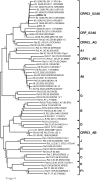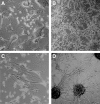Construction and Characterization of Infectious Molecular Clones of HIV-1 CRF63_02A6
- PMID: 31482716
- PMCID: PMC7071090
- DOI: 10.1089/AID.2019.0177
Construction and Characterization of Infectious Molecular Clones of HIV-1 CRF63_02A6
Abstract
Currently, HIV-1 CRF63_02A6 is the prevalent genetic variant of the HIV-infected subjects in the major part of the Siberian Federal District (Russia). The HIV-1 CRF63_02A6 R5-tropic pT11.17 and X4-tropic pMtBs.18 infectious molecular clones (IMCs) were constructed using the virus isolates recovered in 2015 and 2017 of male HIV-infected Russian residents (from Tomsk and Novosibirsk, respectively). Near full-length proviral HIV-1 sequences (9,644 and 9,748 bp) were subcloned in pBluescript II KS(-). The CRF63_02A6 IMC virions were obtained by transfecting HEK293T cells with the constructed plasmids and demonstrated a stable growth in peripheral blood mononuclear cell culture (p24 concentration increased >1,000-fold and the virus protein accumulation in culture liquid exceeded 100,000 pg/mL). The tropism of CRF63_02A6 IMCs was determined genotypically (using Geno2pheno) and phenotypically by cultivating the IMC virions in MT-2, U87-CD4-CCR5, and U87-CD4-CXCR4 cell cultures. The obtained HIV-1 CRF63_02A6 IMCs may be useful in basic and applied research.
Keywords: CRF63_02A6; HIV-1 isolates; infectious molecular clone.
Conflict of interest statement
No competing financial interests exist.
Figures







Similar articles
-
Spatiotemporal dynamics of HIV-1 CRF63_02A6 sub-epidemic.Front Microbiol. 2022 Aug 31;13:946787. doi: 10.3389/fmicb.2022.946787. eCollection 2022. Front Microbiol. 2022. PMID: 36118194 Free PMC article.
-
The features of Tat protein of human immunodeficiency virus type 1 (Retroviridae: Lentivirus: Lentivirus humimdef1) non-A6 variants, characteristic for the Russian Federation.Vopr Virusol. 2024 Dec 15;69(6):524-534. doi: 10.36233/0507-4088-272. Vopr Virusol. 2024. PMID: 39841417
-
HIV-1 dual/mixed tropic isolates show different genetic and phenotypic characteristics and response to maraviroc in vitro.Antiviral Res. 2011 Apr;90(1):42-53. doi: 10.1016/j.antiviral.2011.02.005. Epub 2011 Feb 22. Antiviral Res. 2011. PMID: 21349294
-
Next generation sequencing reveals a high frequency of CXCR4 utilizing viruses in HIV-1 chronically infected drug experienced individuals in South Africa.J Clin Virol. 2018 Jun;103:81-87. doi: 10.1016/j.jcv.2018.02.008. Epub 2018 Feb 15. J Clin Virol. 2018. PMID: 29661652 Free PMC article.
-
HIV-1 subtype C predicted co-receptor tropism in Africa: an individual sequence level meta-analysis.AIDS Res Ther. 2020 Feb 7;17(1):5. doi: 10.1186/s12981-020-0263-x. AIDS Res Ther. 2020. PMID: 32033571 Free PMC article. Review.
References
-
- Gashnikova NM, Zyryanova DP, Astakhova EM, et al. : Predominance of CRF63_02A1 and multiple patterns of unique recombinant forms of CRF63_A1 among individuals with newly diagnosed HIV-1 infection in Kemerovo oblast, Russia. Arch Virol 2017;162:379–390 - PubMed
-
- Bogacheva NV, Blednyh NA, Totmenin AV, et al. : Creation of a collection of current HIV-1 isolates including major Russian genetic variants of the virus. HIV Infect Immunosuppr Dis 2017;9:65–76
Publication types
MeSH terms
LinkOut - more resources
Full Text Sources
Molecular Biology Databases
Research Materials

